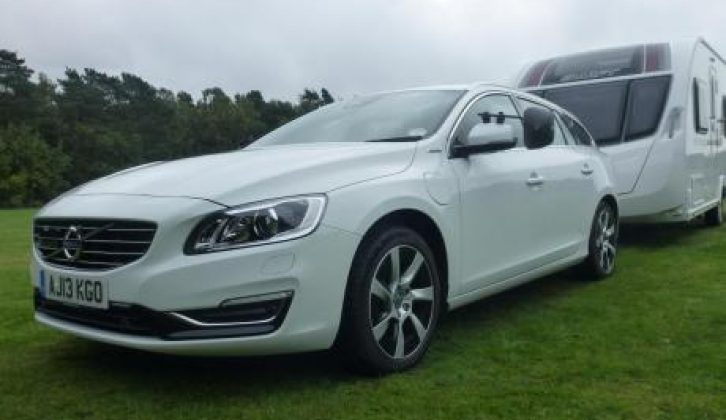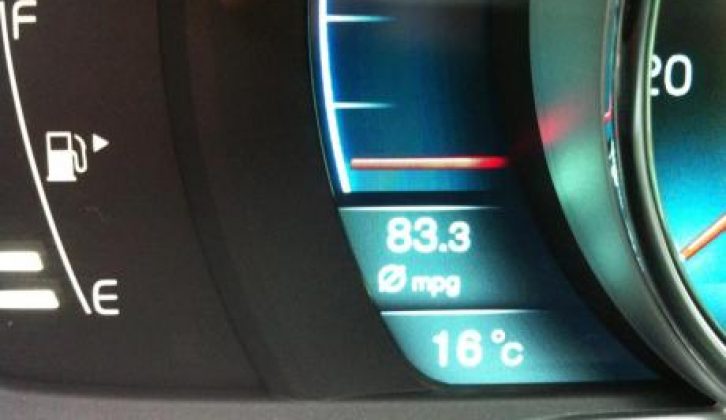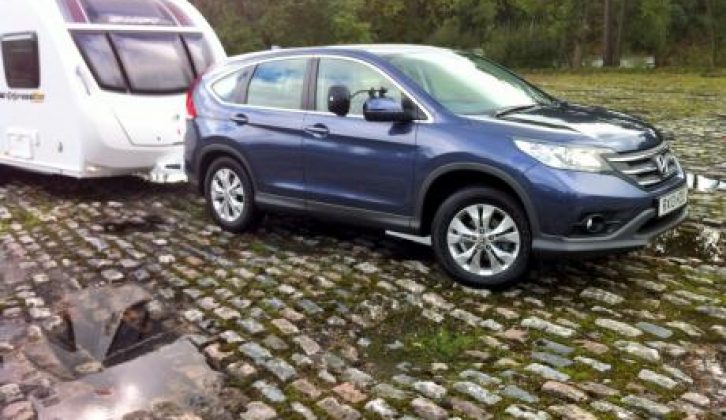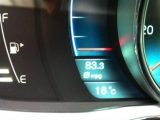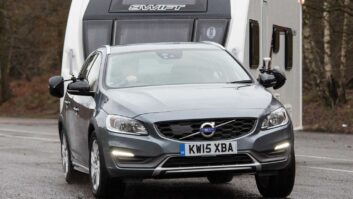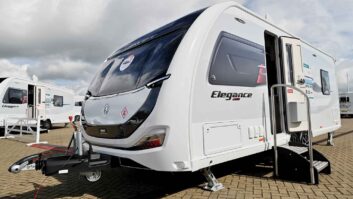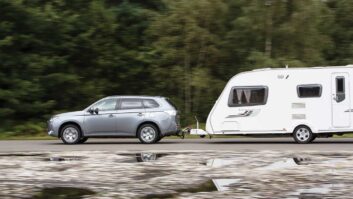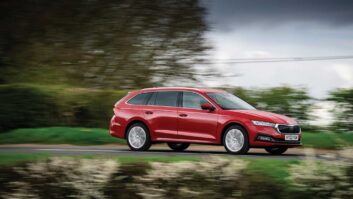One of these cars has 118bhp, the other has 281bhp. So no prizes for guessing which is the car I want.
The Volvo musters its impressive power output by combining a beefy 2.4-litre diesel engine with an electric motor. Since the diesel powers the front wheels and the electric motor powers the rears this makes the Plug-In Hybrid four-wheel drive. Even accelerating hard on a damp surface the V60 has little trouble getting its power to the ground.
Volvo V60: Addictive power, exceptional economy
We hitched up to a Swift Expression 554 with a Mass in Running Order of 1301kg and plugged in our GPS test equipment. With Power mode selected (which allows maximum performance from both the engine and electric motor) the Volvo towed the Swift from 30-60mph in just 6.4 seconds.
The Honda would probably struggle to match that without a caravan behind it. When we swapped the Swift onto the back of the CR-V it needed 17.2 seconds to go from town speeds to the legal limit. Of course, these cars aren’t direct rivals in any way (I drove them back to back but they will be reviewed separately in the magazine) but you can understand why I had more fun towing with the Volvo than the Honda.
I enjoyed the Volvo more as a solo drive, too, for its performance but also for its high-tech powertrain and fuel efficiency. Volvo claims the car will run as far as 31 miles on electric power alone (press the button marked ‘Pure’ on the dash for the car to rely on battery power). That means plenty of daily commutes can be tackled without using a drop of fuel.You then recharge from a domestic socket or, for a quicker battery top-up, a dedicated charge point.
Official figures promise 155.2mpg on the combined cycle. No, I didn’t believe it either. So I set off on a 40-mile loop of A-roads and town driving. At the start of the route the battery was almost fully charged showing a pure electric range of 27 miles.
Even though the car was in ‘Hybrid’ mode, so using both power sources as required, I didn’t hear a peep from the engine for the first six miles, driving at up to 60mph (in theory, the Volvo will go as fast as 77mph using the electric motor). When the engine did cut in it did so smoothly for a quick getaway from an uphill junction, with no sudden jolt or wheelspin. For the next few miles the engine started and stopped as needed, and the trip computer gradually moved from 200mpg down to around 170mpg.
[tl:gallery size=460×343]
With two thirds of the drive complete, the battery’s reserves were drained but the trip computer still showed economy of around 160mpg. Although the battery recharges to some extent under braking, once the charge has dropped low the economy is much less spectacular, but the trip still showed an impressive 83.3mpg at the end of the journey.
Honda CR-V: as sensible and practical as SUVs get
The Honda doesn’t have headline grabbing performance on its side, although the official combined figure of 62.8mpg makes this one of the most economical and efficient diesel SUVs you can buy.
Taking the Swift around our towing economy route, the Honda achieved 28.7mpg. Only a handful of cars have returned better.
Despite the 4×4 looks, this version of the CR-V is two-wheel drive and it’s not hard to briefly spin the front wheels on damp roads when towing. For regular caravanners, especially those with a heavy tourer, the 2.2-litre diesel 4×4 version is a better bet.
However, for fair-weather caravanners or anyone with a lightweight tourer the 1.6-litre diesel’s cheaper price and lower running costs are strong arguments in its favour.
[tl:gallery size=460×343]
After spending time with both the Honda and the Volvo, I started to think how much more easily the Honda would fit into my life. As much as I loved driving the V60, rear legroom is tight and I’d struggle to manage with just 305 litres of boot space (all those electrics have to go somewhere).
By contrast, the Honda is huge inside, with a 589-litre boot and several centimetres more rear legroom. There are all sorts of details which make the Honda practical and easy to live with, like the way the rear doors open to almost right-angles with the car, making it simple to get in and out or fit a child seat.
While the Honda isn’t cheap by any means, with prices starting from £22,800 for the 1.6i DTEC S it’s reasonable value. The Volvo, brilliant tow car though it is, costs £49,275 (or £44,275 with the government’s plug-in car grant). It’s hard to justify when a V60 D5 diesel costs from £33,445, achieves 61.4mpg on the combined cycle and hits 60mph in 7.1 seconds.
As much as I want a V60 Plug-In Hybrid, I couldn’t see myself buying one. The Honda CR-V may be entirely unexciting, but it fulfils the needs of a family of four as well as any SUV I can think of.
Volvo V60 D6 Plug-In Hybrid
Price £44,275 (including £5000 grant)
Kerbweight 2119kg (including 75kg for the driver not included in Volvo’s published kerbweight)
85% match Above legal towing limit
Legal towing limit 1800kg
Honda CR-V 1.6i DTEC SE-T
Price £25,425
Kerbweight 1675kg (including 75kg for the driver not included in Volvo’s published kerbweight)
85% match 1424kg
Legal towing limit 1700kg
